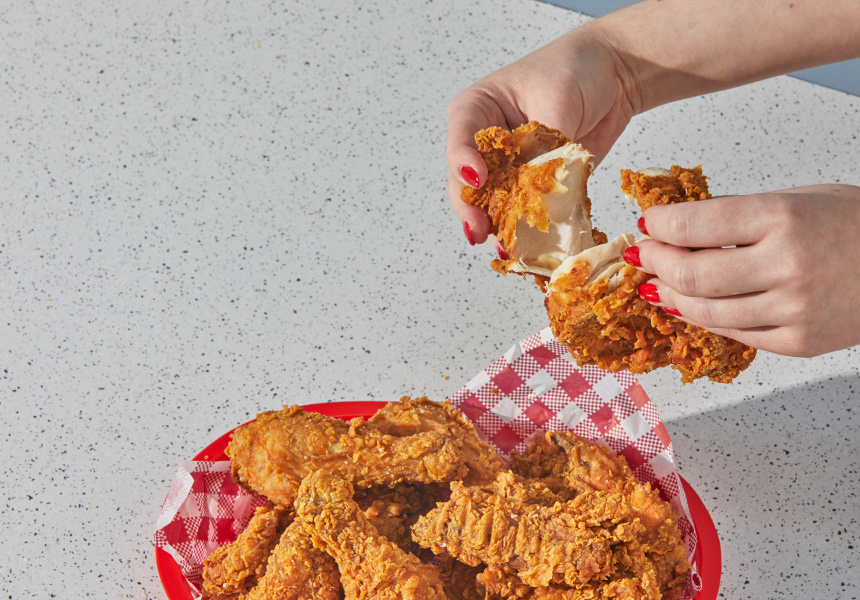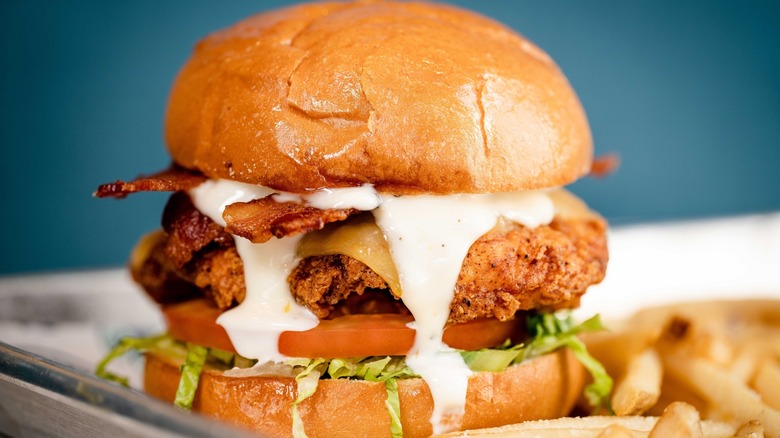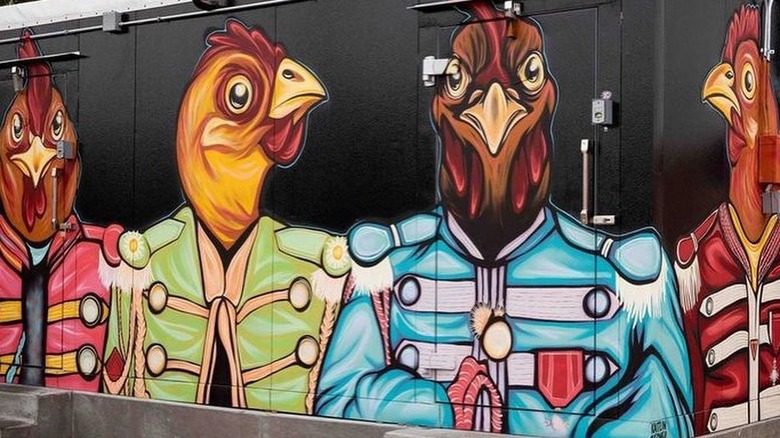Have you ever bitten into a piece of perfectly fried chicken and just closed your eyes in pure bliss? That crispy, crunchy exterior giving way to juicy, tender meat inside? Yeah, me too. I’ve always wondered what makes fried chicken so irresistible – is it magic, or is there actual science behind why we can’t seem to get enough of this comfort food classic?
After diving deep into this finger-lickin’ topic, I’ve discovered there’s a whole lot more to our fried chicken obsession than just tasty coincidence. Let’s break down exactly why fried chicken hits all those pleasure buttons in our brains and bodies.
The Science of Crunch: What Happens in the Fryer
When chicken meets hot oil, some seriously delicious chemistry starts happening. According to Professor Russell Keast, Director of CASS Food Research Centre at Deakin University, frying is typically done between 160-180 degrees Celsius in a deep fryer. At these high temperatures, several key processes occur:
- The Maillard Reaction – This creates those beautiful brown colors and deep flavors when proteins and starches interact
- Moisture Evaporation – Anything above 100 degrees pushes moisture out, creating that signature crunch
- Caramelization – Adding another layer of flavor complexity
“You’re pushing the moisture out, and this creates things like the crunchy textures we associate with fried foods,” explains Prof Keast That perfect level of crispiness isn’t just delicious – it actually sends signals to our brain about food quality and freshness
The Crunch Factor: It’s All in Your Head (Literally)
That satisfying crunch when you bite into perfectly fried chicken does more than just taste good – it creates an actual physical response. The crunch sound literally travels through your jaw bones and vibrates to your ear!
“It’s actually a physical process during mastication that’s creating the sound that reverberates on the jaw bones and takes it to the ear,” Prof Keast notes. This gives us immediate feedback about the food’s freshness and quality.
Think about soggy fried chicken – immediately less appealing, right? Our brains are wired to associate that crisp texture with freshness and quality, making the experience significantly more enjoyable.
Our Evolutionary Love Affair with Salt and Fat
There’s a reason fried chicken feels like it hits a pleasure center in your brain – because it literally does! Our bodies evolved during times when salt and fat were precious, hard-to-find nutrients essential for survival.
“We don’t have great bodily stores of sodium so we needed to replenish it” says Prof Keast. “We needed a response that told us if we came across something with physiologically relevant levels of sodium in it, to consume that.”
The same goes for fat – our ancestors needed to quickly recognize and prioritize foods rich in calories and nutrients. So when we eat fried chicken today, our brains still respond with that evolutionary “jackpot!” signal, flooding us with pleasure chemicals that make us want more.
“When we come across these combinations of salt and fat… our brains are going, ‘This is brilliant’, our evolutionary brains are going, ‘This is fantastic, I’m getting these things which are absolutely essential to me’.”
Why Restaurant Fried Chicken Often Tastes Better Than Homemade
Ever notice how restaurant fried chicken just seems to taste better than what we make at home? There are several good reasons for this:
1. Quality Ingredients
Restaurants typically start with premium chicken. Sarah Goldstone, executive chef at Steuben’s Uptown in Denver, emphasizes: “The quality of the chicken plays a big part. We only use antibiotic-free, humanely-raised chicken.”
Many restaurants also prefer dark meat for frying because it tends to be juicier and handles the frying process better.
2. The Brining Secret
Restaurant chefs know that brining is essential for creating super juicy fried chicken.
“We use a brine made with homemade buttermilk and season it in our signature spice blend,” Goldstone reveals. Restaurants often brine their chicken for days before frying, allowing flavors to fully penetrate the meat and keep it moist during cooking.
3. Perfected Breading Technique
The breading makes a huge difference in fried chicken quality. Restaurants have perfected their recipes and techniques, including:
- Using the right flour blend
- Seasoning both the brine AND the breading
- Double-breading for optimal crispiness
- Avoiding over-breading (you want to taste chicken, not just coating)
“We think a standard flour and herb breading is best, bringing a traditional flavor and crust,” says Goldstone. Many restaurants also let the chicken rest in the breading overnight before frying.
4. Professional Equipment & Technique
Restaurant-grade deep fryers maintain precise temperatures better than home setups. At Steuben’s, they “like to keep our fryers between 275 and 300 degrees. And we cook it until it reaches an internal temperature of 165 degrees.”
They also adjust cooking times based on chicken parts: “We fry the parts of the chicken for different times to take care with the leaner breast meat vs the dark meat,” Goldstone explains.
5. Proper Resting Technique
After frying, restaurants place chicken on drying racks rather than paper towels. “We keep ours on drying racks, always making sure to keep it out of the grease while it rests,” says Goldstone. This keeps the exterior crispy instead of soggy.
Creating Restaurant-Quality Fried Chicken at Home
Wanna make fried chicken at home that rivals your favorite restaurant? Here’s what I’ve learned you should focus on:
- Start with quality chicken – Free-range, antibiotic-free if possible
- Brine thoroughly – Buttermilk brine with herbs and spices for at least 24 hours
- Season in layers – Season the brine, the chicken itself, and the breading mixture
- Double-bread properly – But don’t overdo it; balance is key
- Use a thermometer – Keep oil at 275-300°F and cook to an internal temp of 165°F
- Use drying racks – Never drain on paper towels
- Fry different pieces differently – Adjust time based on size and white/dark meat
Perfect Pairings: Completing the Fried Chicken Experience
The full fried chicken experience isn’t just about the chicken itself – what you serve alongside matters too! Classic Southern sides elevate the meal:
- Mashed potatoes and gravy
- Collard greens
- Mac and cheese
- Buttermilk biscuits
- Pickles (lots of them!)
Amador Acosta, VP of Culinary & Innovation at Birdcall, emphasizes the importance of pickles in particular: “Pickles add a delightful crunch and tanginess to the sandwich. Ensure a generous and even distribution of thick-cut pickles to get the best balance.”
For fried chicken sandwiches, the bun selection is critical too. “The humble bun is often overlooked but is a core component,” says Acosta, who recommends a brioche bun for its “flavor, appealing look, and softness. It also gives a great contrast to the fried chicken.”
The Commitment to Quality
What truly separates outstanding fried chicken from merely good fried chicken is an unwavering commitment to quality at every step. The best restaurants never cut corners, from ingredient selection to preparation techniques to final presentation.
“At Birdcall, the focus is on delivering a superior chicken sandwich that stands out,” Acosta explains. “We love to focus on the details — the quality of our buns, our chicken, our carefully crafted toppings.”
Why We Just Can’t Resist
So there you have it – fried chicken isn’t just randomly delicious. It’s hitting on multiple levels: satisfying ancient evolutionary cravings, triggering physical responses through sound and texture, and delivering complex flavors through careful preparation.
The next time you bite into that perfect piece of fried chicken and feel that rush of happiness, you’ll know exactly why your brain is doing a little happy dance. It’s not just in your head (well, technically it is), but there’s solid science behind why fried chicken remains one of the most universally beloved foods across cultures and generations.
What’s your favorite way to enjoy fried chicken? Classic Southern style? Nashville hot? In a sandwich with pickles? I’d love to hear about your personal fried chicken preferences in the comments!

Restaurants always choose the right bun for fried chicken sandwiches

In addition to the chicken you select and how you prep and cook it, what you serve alongside your fried chicken matters. Amador Acosta, vice president of Culinary & Innovation at Birdcall agrees: “The same thoughtfulness and particularity we take with our chicken extends to all the other ingredients we serve. From the buns to the chicken and toppings, every element is carefully chosen and prepared to ensure a high-quality product that Birdcall is proud to serve.” You should do the same at home. Even if you do everything else restaurants recommend, one subpar ingredient diminishes your fried chicken in the end.
At Birdcall, they serve unbelievably tasty fried chicken sandwiches, so buns in particular are a main priority. “The humble bun is often overlooked but is a core component that can sneak up on you if done incorrectly,” says Acosta. Thats why Birdcall worked with Harvest Moon Bakery to develop an exclusive bun that wont droop or become mushy under the weight of sauces and toppings. He also says, “A brioche bun is highly recommended for its flavor, appealing look, and softness. It also gives a great contrast to the fried chicken.” Acosta suggests giving the bun a good toast for added texture and flavor. Plus, it ensures “your sandwich and ingredients stay in one place.” So, dont forget to use top-quality ingredients all around, and never underestimate the power of a good burger bun.
Restaurants start with top-quality chicken

One of the main reasons restaurants potentially serve tastier fried chicken than you make at home is that they start with premium chicken. Many people think any chicken you get from the store is basically the same and how you prep fried chicken is what truly matters. While this is partly true, starting with top-quality poultry goes a long way. According to Sarah Goldstone, executive chef at Steubens Uptown, “The quality of the chicken plays a big part. We only use antibiotic-free, humanely-raised chicken.” Goldstone adds that better quality poultry is tantamount to better taste. And she says, “Dark meat is usually more juicy and handles being fried better.” So, not only is it the quality of the meat, but whether it is dark or white meat matters too.
Vice president of Culinary & Innovation at Birdcall, Amador Acosta, confirms quality is key: “Quality ingredients and meticulous attention to detail set Birdcall apart. Throughout our locations, we exclusively use all-natural chicken with strict quality control measures to ensure consistency and taste in every bite.” Birdcall also hand cuts and trims all of the chicken to ensure nothing less than the best slips through. Acosta recommends you do the same for homemade batches: “At home, be mindful of the quality of the chicken, paying attention to where it came from and how it was treated.” Unsurprisingly, all the little details matter, and the meat itself is one you certainly shouldnt overlook.
10 Reasons Why KFC’s Fried Chicken Is SO DELICIOUS!!!
FAQ
What makes fried chicken taste so good?
Fried chicken is so good due to the combination of sensory and chemical reactions it undergoes during cooking: the Maillard reaction and caramelization create complex, savory flavors, while the high heat and fat from frying produce a satisfyingly crispy exterior that contrasts with the juicy, tender chicken inside. The rich fat absorbed during frying further enhances the dish’s flavor, and the added herbs and spices in the coating provide aromatic complexity.
Is fried chicken really unhealthy?
Yes, fried chicken is generally unhealthy because the deep-frying process adds unhealthy fats, omega-6 fatty acids, and calories from oil absorption and breading, while also destroying nutrients and creating potentially harmful compounds like acrylamide and trans fats. The high fat and calorie content contributes to inflammation, obesity, and an increased risk of heart disease, diabetes, and cancer. However, it can be consumed in moderation as part of a balanced diet, and healthier cooking methods like air-frying or baking can significantly reduce the fat and calorie content.
Why do people like fried chicken?
People like fried chicken because it offers an appealing combination of crispy texture, savory flavor, and comforting qualities, while also having deep historical, cultural, and sentimental roots, particularly within African American and Southern traditions. The way it was able to travel well before refrigeration also helped its widespread adoption.
Why do I crave fried chicken so much?
You may be craving fried chicken due to stress, a lack of nutrients like protein or healthy fats, dehydration, or simply a desire for a hyper-palatable, high-calorie food that stimulates brain reward centers. Your cravings could also be linked to a period or hormonal changes, or they could be a learned habit from frequently consuming fried foods.
